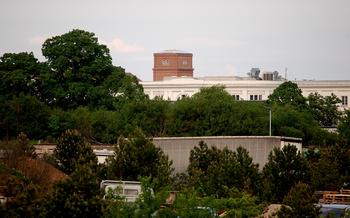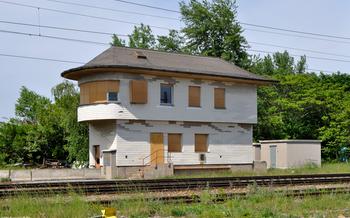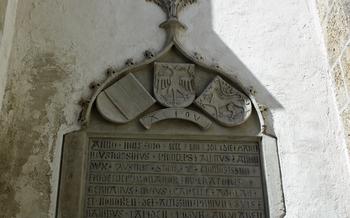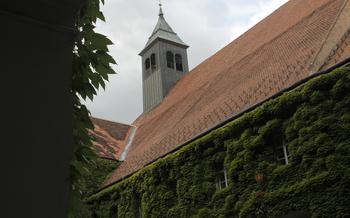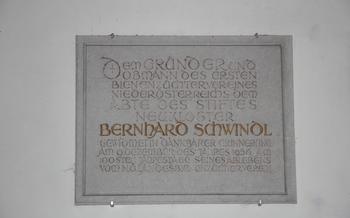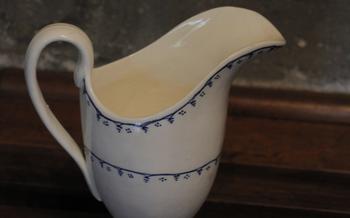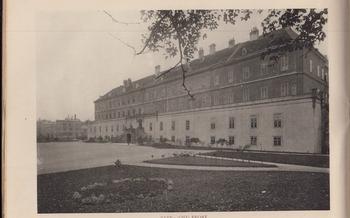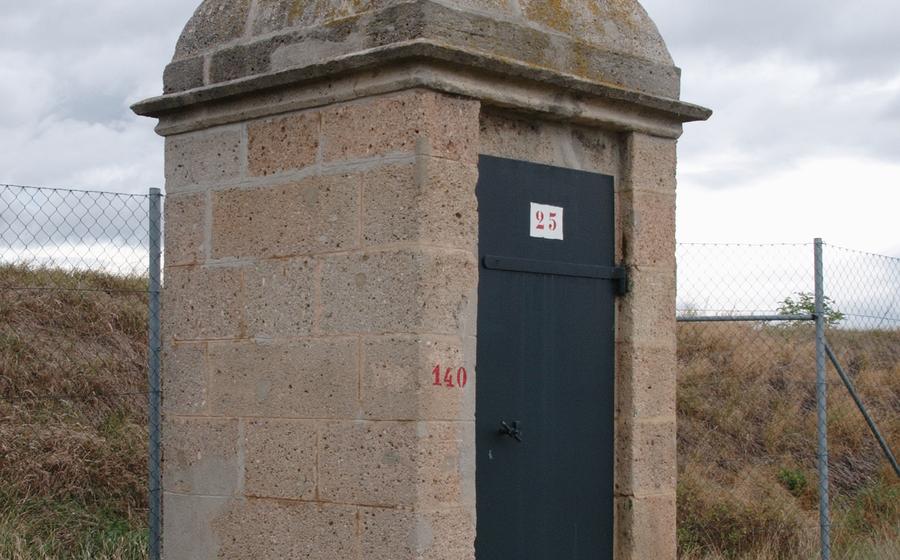
Araburg Castle Ruins
- Araburg Castle Ruins: An Overview
- Exploring the Castle Grounds
- Historical Importance of Araburg Castle:
- Architectural Features:
- The Castle's Role in Warfare:
- Excavations and Discoveries
- Restoration Efforts
- Visiting Information
- Events and Activities
- Nearby Attractions
- Accommodation and Dining
- Local Culture and Traditions:
- Photography Opportunities
- Insider Tip:
Araburg Castle Ruins: An Overview
Araburg Castle, a majestic testament to history and architectural prowess, stands as a reminder of Austria's rich past amidst the modern cityscape of Wiener Neustadt. Its ruins, a blend of Romanesque and Gothic styles, evoke an aura of mystery and grandeur, inviting visitors to delve into the depths of time.
Located on a hill overlooking the city, Araburg Castle offers panoramic vistas of the surrounding landscape, stretching from the rolling hills of the Vienna Woods to the distant peaks of the Alps. The site is easily accessible by car or public transportation, making it a convenient destination for both domestic and international travelers.
During your visit to Araburg Castle, you can wander through the ruins, exploring the remnants of towers, walls, and gates that once formed a formidable fortress. Interpretive signs and guided tours provide insights into the castle's history, allowing visitors to connect with the lives and legends of those who once inhabited these walls.
Legends and tales abound, adding to the allure of Araburg Castle. The most prominent among them is the tale of the "White Lady," a ghostly figure said to roam the castle grounds, forever searching for her lost love. These stories, passed down through generations, contribute to the castle's mystique, captivating visitors with their blend of history and folklore.
Exploring the Castle Grounds
Emerging from the depths of history, the Araburg Castle ruins stand as a testament to the architectural prowess of a bygone era. As you traverse the castle grounds, you'll encounter a tapestry of ancient structures, each whispering tales of a glorious past. Explore the towering fortifications, where sturdy walls and imposing towers once guarded the realm against invaders. Gaze upon the remnants of majestic gates, their arches silently echoing the footsteps of knights and nobles who once graced these grounds.
Amidst the ruins, discover unique features that set Araburg Castle apart. Admire the intricate carvings adorning the walls, each stroke a testament to the artisans' mastery. Unearth hidden chambers and secret passageways, where history seems to linger in the shadows. Ascend to the battlements and be rewarded with panoramic vistas that stretch beyond the castle walls, offering breathtaking views of the surrounding countryside.
Venture beyond the castle's confines and immerse yourself in the natural beauty that envelops the site. Embark on a rejuvenating nature walk, following winding trails that lead you through verdant forests and babbling brooks. Breathe in the fresh air, invigorated by the scent of wildflowers and the melodious songs of birds. Whether you seek solitude or adventure, the castle grounds offer a sanctuary for all who wander within its embrace.
Historical Importance of Araburg Castle:
Araburg Castle, with its strategic location and formidable fortifications, played a significant role in various historical periods, particularly during the Middle Ages. The castle's imposing presence and defensive capabilities made it a key stronghold for the local lords and a symbol of power and authority.
In the 12th century, Araburg Castle was at the center of several conflicts and battles, as rival factions sought to control the region. Its strong fortifications and strategic position allowed it to withstand numerous sieges and attacks, demonstrating its military significance.
Throughout the centuries, Araburg Castle remained a vital defensive structure, protecting the surrounding lands and serving as a refuge during times of turmoil. Notable historical figures and events are associated with the castle, including the legendary knight Ulrich von Liechtenstein, who is said to have resided there in the 13th century.
In later periods, Araburg Castle gradually lost its military importance as warfare strategies evolved, and it eventually fell into disuse and abandonment. However, its historical legacy and architectural value have ensured its preservation as a cherished cultural heritage site, attracting visitors and history enthusiasts from around the world.
Current efforts are focused on preserving and restoring the castle ruins, ensuring that this important piece of history continues to stand as a testament to the region's rich past and enduring legacy.
Architectural Features:
The Araburg Castle ruins showcase a unique blend of Romanesque and Gothic architectural styles, reflecting the evolving tastes and construction techniques of different historical periods. The castle's fortifications, including its towers, walls, and gates, are particularly noteworthy. The towers, with their distinctive shapes and heights, provided strategic vantage points for defense and observation. The walls, adorned with intricate stonework, demonstrate the skill and craftsmanship of the builders. The gates, once the main entrances to the castle, feature impressive archways and heavy iron fittings, hinting at the castle's defensive capabilities.
The use of local materials, such as limestone and sandstone, adds to the authenticity and charm of the ruins. These materials have weathered over time, creating a harmonious blend of natural elements and human craftsmanship. The castle's architecture reflects its primary function as a defensive stronghold, with a focus on protection and security. Despite its military purpose, the castle's design also incorporates aesthetic elements, such as decorative carvings and ornamental features, showcasing the artistic sensibilities of its builders.
The Castle's Role in Warfare:
Araburg Castle played a crucial role in medieval conflicts and wars due to its strategic location and formidable defenses. During the 12th and 13th centuries, the castle served as a stronghold for the Babenberg dynasty, who used it to protect their territories and repel invaders. Its thick walls, towers, and gates made it virtually impregnable, allowing it to withstand numerous sieges and attacks.
One of the most notable battles associated with Araburg Castle occurred in 1246, when the Hungarian king Béla IV laid siege to the castle in an attempt to conquer Austria. Despite the Hungarian army's superior numbers, the castle's defenders held their ground for several months, eventually forcing Béla IV to lift the siege and retreat.
The castle's strategic importance continued throughout the Middle Ages, as it was frequently contested by rival factions and armies. In the 15th century, the castle was captured by the Hussites, a religious and military movement from Bohemia, who used it as a base for their campaigns in Austria. The castle eventually fell into disrepair and was abandoned, but its imposing ruins still stand as a testament to its significance as a military stronghold.
Excavations and Discoveries
Archaeological excavations conducted at the Araburg Castle site have unearthed a wealth of artifacts and remnants that shed light on the castle's past. These excavations, meticulously carried out by teams of archaeologists, have revealed foundations, pottery fragments, tools, weapons, and other remnants of daily life within the castle walls.
The discoveries made during these excavations have provided valuable insights into the lives of the castle's inhabitants, their customs, and their activities. Archaeologists have uncovered evidence of living quarters, kitchens, workshops, and storage areas, piecing together the daily routines and interactions of the people who once called Araburg Castle home.
These excavations have also uncovered structural elements that provide clues to the castle's construction and evolution over time. Foundations of towers, walls, and gates have been unearthed, revealing the defensive systems and architectural techniques employed in building the castle. The findings from these excavations have contributed significantly to our understanding of Araburg Castle's history, its strategic importance, and its role in the region's medieval past.
Restoration Efforts
Araburg Castle has undergone extensive restoration efforts over the years, aimed at preserving its historical integrity while ensuring its longevity. These efforts are meticulously carried out by skilled professionals who employ various techniques and methods to stabilize and reconstruct the ruins.
One of the primary tasks involves reinforcing the castle's walls, towers, and gates using a combination of traditional and modern techniques. This includes repairing damaged stonework, filling in gaps, and strengthening structural elements to prevent further deterioration.
Another crucial aspect of the restoration process is addressing the impact of vegetation on the ruins. Overgrowth can cause damage to the stonework and compromise the overall stability of the structures. Therefore, careful removal of invasive plants and controlled landscaping are essential to preserving the castle's integrity.
Archaeological excavations conducted at the site have also played a vital role in guiding the restoration efforts. By uncovering foundations, artifacts, and other remnants of the castle's past, archaeologists provide valuable insights into its original layout and architectural details. This information is then used to inform the restoration process, ensuring that the castle's historical character is maintained.
The restoration of Araburg Castle is an ongoing and challenging endeavor, but it is crucial for preserving this significant cultural heritage site for future generations. Through these efforts, the castle's rich history and architectural beauty can continue to be appreciated and enjoyed by visitors from around the world.
Visiting Information
Planning a visit to Araburg Castle Ruins is a rewarding experience for history and architecture enthusiasts. Here are some practical details to ensure a smooth and enjoyable visit:
-
Admission Fees: Entry to the castle ruins is free of charge, allowing visitors to explore the site at their leisure.
-
Opening Hours: The castle is accessible to the public daily from dawn to dusk. Visitors can wander through the ruins and immerse themselves in the historical atmosphere at their convenience.
-
Guided Tours: Guided tours are available upon request for groups or individuals seeking a more in-depth understanding of the castle's history and significance. Advance booking is recommended to secure a spot.
-
Accessibility: The castle ruins are partially accessible for visitors with disabilities or special needs. While some areas may be challenging to navigate due to uneven terrain, efforts have been made to provide accessible routes wherever possible.
-
Planning Your Visit: To make the most of your visit, consider the following tips:
- Best Time to Visit: Avoid visiting during peak tourist season (July-August) to avoid crowds and enjoy a more serene experience. Spring and fall offer pleasant weather and fewer visitors.
-
Things to Bring: Wear comfortable shoes suitable for walking on uneven surfaces. Bring a camera to capture the castle's beauty and a flashlight if exploring dimly lit areas.
-
Contact Information: For further inquiries or bookings, visitors can contact the local tourist information office or refer to the castle's official website for additional details and updates.
Events and Activities
Araburg Castle Ruins is not just a historical site; it is also a vibrant venue for various events and activities that bring history to life. Throughout the year, the castle grounds host a range of events that immerse visitors in the medieval world and showcase the cultural heritage of the region.
Medieval reenactments transport visitors back in time, as costumed actors bring to life the castle's past. These events recreate historical battles, tournaments, and daily life in the castle, offering a glimpse into the era of knights, ladies, and chivalry.
Historical demonstrations provide hands-on experiences for visitors, allowing them to try their hand at archery, learn about medieval crafts, or witness traditional cooking techniques. These demonstrations offer a deeper understanding of the skills and practices that shaped life within the castle walls.
Cultural performances, such as concerts, plays, and dance shows, are held within the atmospheric setting of the castle ruins. These events showcase local talent and provide a unique backdrop for artistic expression, creating a memorable experience for both performers and attendees.
Outdoor concerts, picnics, and photography workshops are also popular events that take advantage of the castle's picturesque surroundings. Visitors can enjoy live music, relax on the castle grounds with a picnic basket, or capture stunning photographs of the ruins in different lights and seasons.
These events and activities not only enhance the castle's appeal but also contribute to its cultural significance, making it a dynamic and engaging destination for visitors from all walks of life.
Nearby Attractions
Araburg Castle is not the only historical gem in the region. Nearby, you can explore the enchanting town of Wiener Neustadt, home to the majestic Wiener Neustadt Cathedral, a splendid example of Gothic architecture. The cathedral's intricate details and soaring spires are a sight to behold, making it a must-visit for history and architecture enthusiasts.
For a glimpse into the region's military heritage, head to the Museum St. Peter an der Sperr, housed within a former monastery. This fascinating museum showcases a collection of medieval weapons, armor, and artifacts, providing insights into the area's turbulent past.
Nature lovers will delight in exploring the nearby Hohe Wand Nature Park, a stunning natural reserve with breathtaking views, hiking trails, and opportunities for wildlife spotting. The park's rugged cliffs, lush forests, and panoramic vistas make it a perfect destination for outdoor enthusiasts seeking adventure and tranquility.
By combining a visit to Araburg Castle with these nearby attractions, you can create a comprehensive itinerary that offers a rich blend of history, culture, and natural beauty, ensuring a memorable and enriching travel experience.
Accommodation and Dining
When planning your visit to Araburg Castle, a variety of accommodation options are available to suit different preferences and budgets. For a truly immersive experience, consider staying in one of the charming guesthouses or vacation rentals in the vicinity of the castle. These accommodations often offer a cozy and authentic atmosphere, allowing you to soak in the historical ambiance of the area.
For those seeking a more modern and luxurious stay, there are several hotels within a short distance of the castle. These hotels offer comfortable rooms, amenities, and convenient locations, making them an ideal choice for travelers looking for a comfortable and convenient base from which to explore the region.
When it comes to dining, there are several excellent restaurants and cafes in the area, serving a range of local and international cuisine. Indulge in traditional Austrian dishes, such as Wiener Schnitzel or Tafelspitz, at one of the local restaurants, or savor the flavors of international cuisine at one of the many international restaurants in the area.
To make the most of your culinary experience, be sure to try the local wines, which are renowned for their quality and variety. Whether you prefer a crisp white wine or a robust red, you're sure to find a wine that complements your meal perfectly.
Remember, the local gastronomy is an integral part of the cultural experience of visiting Araburg Castle. Embrace the opportunity to sample the local cuisine and discover the unique flavors and culinary traditions of the region.
Local Culture and Traditions:
Immerse yourself in the vibrant local culture and traditions of the region surrounding Araburg Castle. Experience the warmth and hospitality of the local people as you delve into their unique customs and festivals. Attend traditional events that showcase the region's rich heritage, such as folk music performances, colorful parades, and lively markets. Engage with the locals, learn about their way of life, and savor the flavors of their delectable cuisine. Embrace the opportunity to connect with the community and gain a deeper understanding of the region's cultural tapestry. This immersion in local culture will enrich your visit to Araburg Castle and provide a truly authentic travel experience.
Photography Opportunities
Araburg Castle Ruins present a photographer's paradise, offering a wealth of opportunities to capture stunning images. The castle's unique blend of architectural styles and its picturesque surroundings create a captivating backdrop for photography enthusiasts.
The best lighting conditions for capturing the castle's grandeur are during the golden hours of sunrise and sunset. The warm, diffused light casts a magical glow on the ruins, highlighting their intricate details and textures.
For panoramic views, head to the castle's highest point, where you can capture breathtaking vistas of the surrounding countryside. The lush greenery, rolling hills, and distant villages create a picturesque frame for the castle ruins.
Don't miss the opportunity to explore the hidden corners and secret passages of the castle. These secluded spots offer unique perspectives and intimate views of the ruins, allowing you to capture their haunting beauty and historical charm.
To fully immerse yourself in the experience, consider participating in a photography workshop or tour led by a local photographer. These workshops provide expert guidance, helping you master the art of capturing the castle's essence through your lens.
Whether you're an amateur photographer or a seasoned professional, Araburg Castle Ruins offer endless possibilities for capturing stunning images that will serve as lasting mementos of your journey through history.
Insider Tip:
For a truly unique and unforgettable experience, venture beyond the main castle grounds and explore the nearby Araburg Forest. This hidden gem offers a serene and tranquil setting, where you can immerse yourself in the natural beauty of the area. Follow the winding forest trails, discover hidden streams and waterfalls, and admire the diverse flora and fauna. Take a moment to pause and listen to the sounds of nature, allowing yourself to connect with the peaceful surroundings. Pack a picnic lunch and find a secluded spot to enjoy a leisurely meal amidst the tranquil forest atmosphere. Remember to bring your camera to capture the stunning scenery and wildlife encounters along the way.

